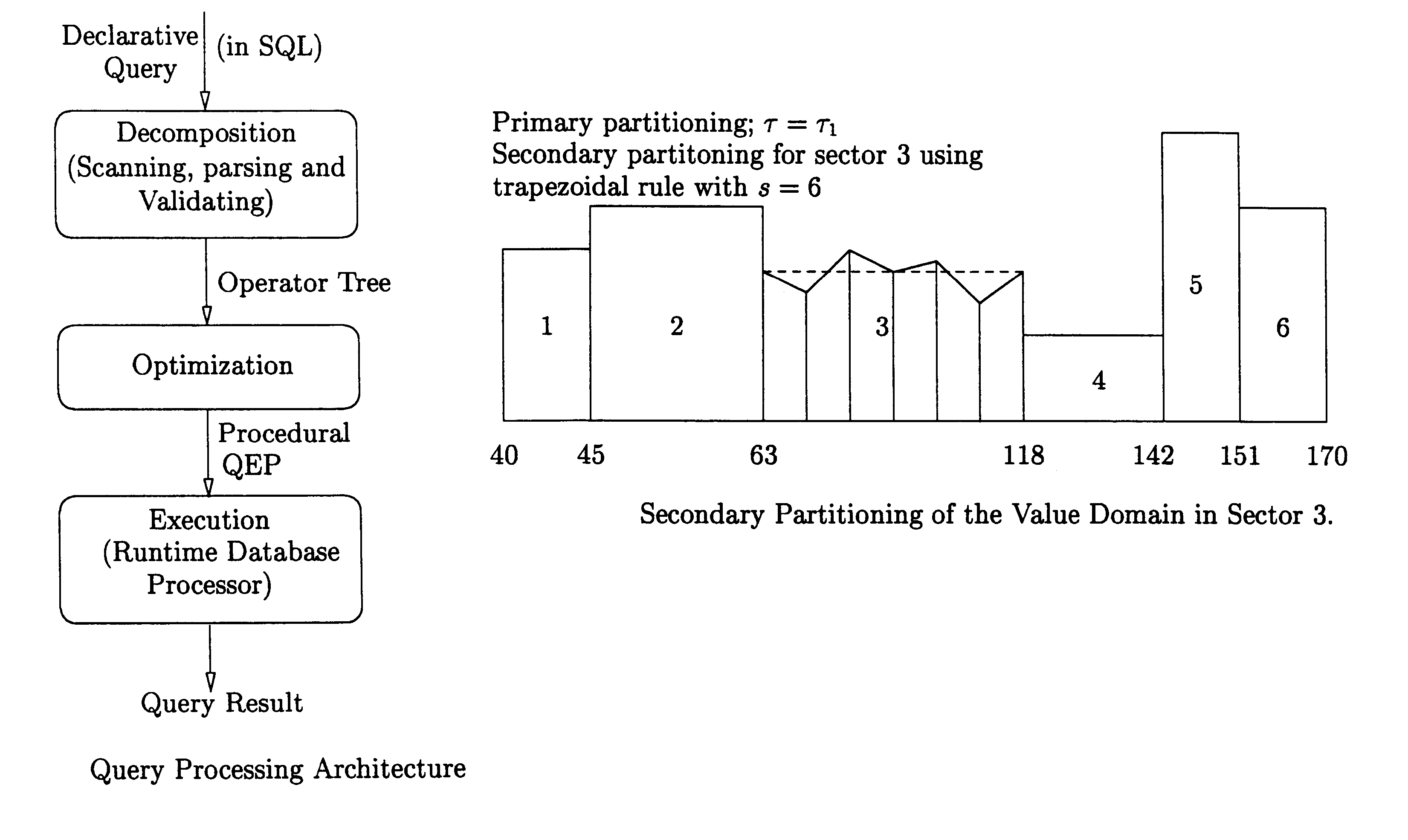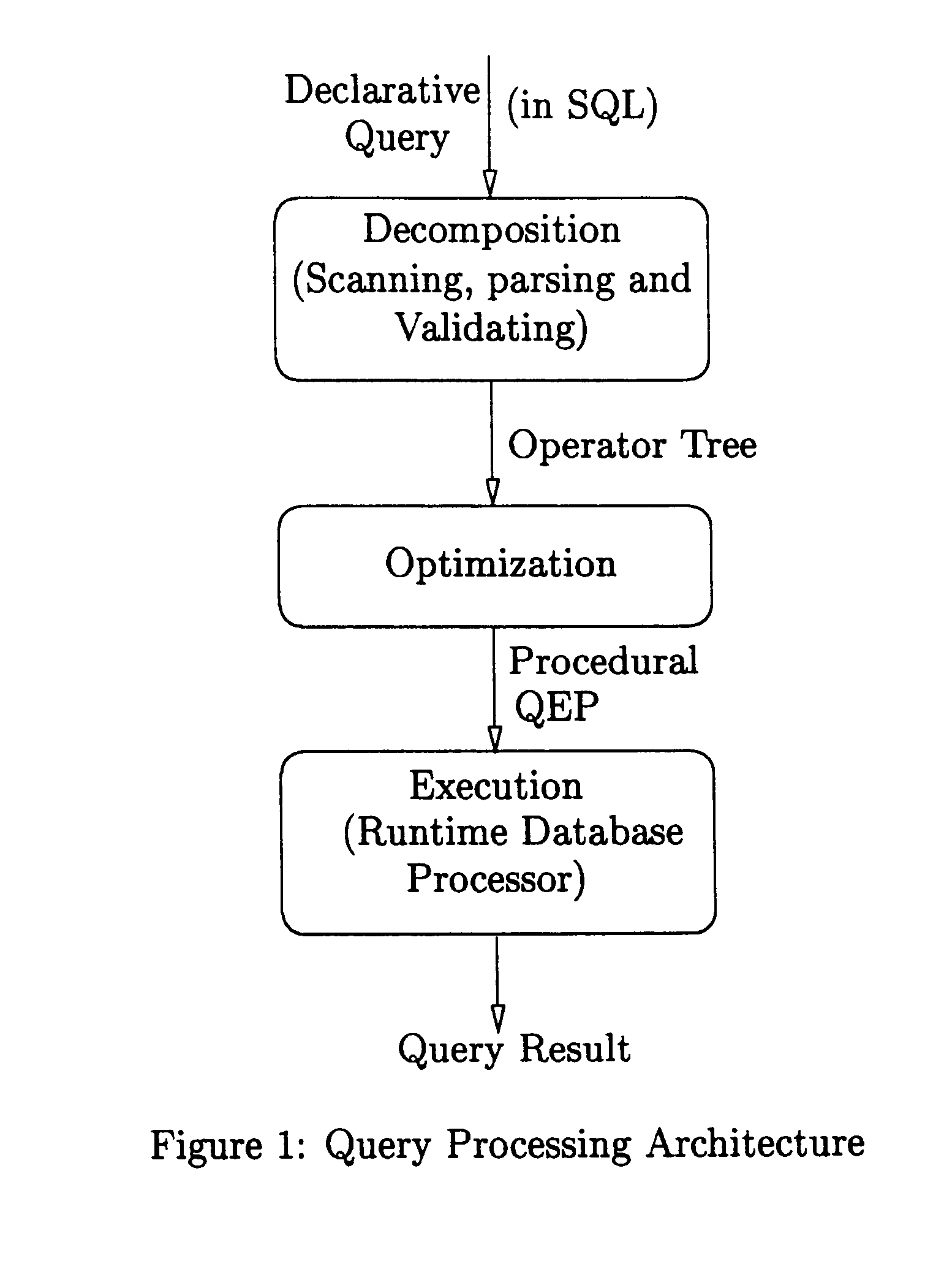Method of generating attribute cardinality maps
a cardinality map and attribute technology, applied in the field of estimation, can solve the problems of preventing the practical application of these methods, substantial errors, and computational costs in determining the histogram and/or statistical information relating to estimation accuracy
- Summary
- Abstract
- Description
- Claims
- Application Information
AI Technical Summary
Benefits of technology
Problems solved by technology
Method used
Image
Examples
example 1
FIG. 11 shows the histogram and the R-ACM of the Age attribute of a relation Emp(SIN, Age, Salary) between Age=30 and Age=49. Note that the actual frequency for every age value is shown in the histogram as shaded rectangles. Whenever the frequency of the current age differs from the frequency of the running mean value for age in the sector by more than the allowed tolerance value τ=8, a new partition is formed. From the ACM, the number of tuples in this relation with ages in the range of 34≦Age≦36 is 130 and the estimate for the number of employees having age=48 is 15 / 3=5.
Pseudocode to implement the above method is as follows.
Method 2 Generate_R-ACM
Input: tolerance τ, frequency distrib. of X as A[0 . . . L−1]Output: R-ACMbeginInitialize_ACM; / * set all entries in ACM to zero * / current_mean:=A[1]; j:=0;ACM[j]:=A[1];for i:=1 to L−1 do / * for every attribute value * / if abs (A[i]−current mean)<τACM[j]:=ACM[j]+A[i]; / * compute the running mean * / current_mean:=(current_mean*i+A[i]) / (i...
example 2
Consider an R-ACM sector of width 10 containing 124 tuples, where the R-ACM is partitioned using a tolerance value τ=3. Let us attempt to find the estimated frequency ranges for the attribute values (a) X3 and (b) X6.
(a). The frequency range of X3 is, 12.4-3(ln 5-1)≤x3≤12.4+3(ln 5-1)10.57≤x3≤14.23
(b). The frequency range of X6 is, 12.4-3(ln 2-1)≤x6≤12.4+3(ln 2-1)11.48≤x6≤13.32
Notice that in both the above cases, the possible frequency values from an equi-width or equi-depth histograms are 0≦x≦124, where x=x3 or x6. The power of the R-ACM in the estimation is clearly advantageous.
5.1.9 Worst-Case Error in Estimating the Frequency of an Arbitrary Value Xi
The previous theorem gives an estimate of the number of occurrences of an arbitrary attribute value by considering the worst-case R-ACM sector. So the worst-case error in the above estimate is given by the frequency range that the attribute value can assume. The following theorem provides a worst-case error for this frequ...
example 3
FIG. 26 shows the equi-width histogram and the trapezoidal ACM of the Age attribute of a relation Emp(SIN, Age, Salary) between Age=30 and Age=49. Note that the actual frequency for every age value is shown in the histogram as shaded rectangles. The starting and ending frequencies of each trapezoidal sector is chosen so that the area under the trapezoid is equivalent to the area of the corresponding rectangular sector of the histogram. From the trapezoidal ACM, the number of tuples in the relation with ages in the range of 35≦Age<40 is 283 and the estimate for the number of employees having Age=48 is 6. Compare this with the rectangular ACM in Example 1.
Finding the result size of a selection query on a range-predicate is a discrete case of finding the area under a curve. Thus any numerical integration technique used to find the area under a curve will fit our purpose well. More accurate and sophisticated methods such as Simpson's Rule exist which may also be used. The trapezoid...
PUM
 Login to View More
Login to View More Abstract
Description
Claims
Application Information
 Login to View More
Login to View More - R&D
- Intellectual Property
- Life Sciences
- Materials
- Tech Scout
- Unparalleled Data Quality
- Higher Quality Content
- 60% Fewer Hallucinations
Browse by: Latest US Patents, China's latest patents, Technical Efficacy Thesaurus, Application Domain, Technology Topic, Popular Technical Reports.
© 2025 PatSnap. All rights reserved.Legal|Privacy policy|Modern Slavery Act Transparency Statement|Sitemap|About US| Contact US: help@patsnap.com



